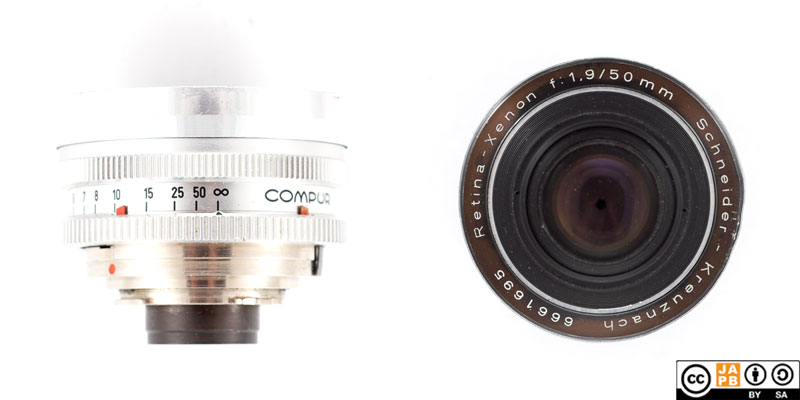Pekka Buttler, 08/2023

Specifications
The table below summarizes the lens’ key specifications (Measurements based on pictured sample):
| Brand: | Schneider-Kreuznach | Lens name | Retina-Xenon f:1,9/50 mm |
| Focal length(s) 1 | 50 mm | Angle-of-view 2 | ≈ 45 ° |
| Maximum Aperture | f/1.9 | In Production | 1959–1974 |
| Lens mounts | DKL | Subfamily (if applicable) | DKL/Retina |
| Length 3 | 35,8 mm | Diameter 4 | 59,8 mm |
| Filter ring diameter | 58 mm | Weight | 211 grams |
| Lens element count | 6 | Lens group count | 4 |
| Aperture blades (S/R/C) 5 | 5 S | Focus throw | 160 ° |
| Minimum focusing distance | 1 m | Maximum magnification | 1:17,9 |
| Has manual aperture ring | NO | Has Manual focus ring | YES |
| Aperture mechanism type | Automatic | Aperture click stops | N/A |
Further notes:
• This lens is a DKL-mount lens (see the article on the DKL mount), and therefore does not have an aperture ring (the aperture ring was on the camera-end of the mount).
• All DKL mount lenses – irrespective of manufacturer – follow a very similar design and aesthetic. Part of that design is defined by the structure of the leaf shutter integrated in the mount, but it seems that manufacturers followed a common playbook regarding colors (silver), typography, ergonomics and usability.
• While some of these aspects are admirable (such as the red ‘whiskers’ that change to indicate depth-of-field at the chosen aperture), others are a bit tedious (generally narrow, rather heavy focus rings).
• Due to the key design limitation of the DKL mount (the size of the camera’s leaf shutter defining the maximum size of a lems’ rear element), the DKL mount is characterised by (for today’s standards) the lack of really fast lenses. In fact, the two fastest lenses offered for the DKL mount are this Schneider-Kreuznach Xenon 50 mm f/1.9 and the similar-spec Rodenstock Heligon. These were closely shadowed by the Voigtländer Septon 50 mm f/2 [data sheet] and Voigtländer 40 mm f/2 Skopagon.
History of Schneider-Kreuznach
Schneider-Kreuznach is the veritable optics decathlete, in that they have manufactured high-quality optics and lenses for pretty much every imaginable platform ranging from mobile phone camera lenses to large format lenses, enlarger, repro and macro lenses, projector lenses, cine lenses, and various industrial applications. See more in the JAPB company profile on Schneider-Kreuznach.
History of the Xenon
The Xenon-design’s history reaches as far back as 1925. That year the young (born 1902) lens designer Albrecht Tronnier designed the 5cm f/2 lens, which was later (1935 refined into the 50 mm f/1.9 lens, as which it is the subject of this data sheet. Tronnier later went on to head lens design at Voigtländer, where he is credited with a spate of quite revolutionary designs (including the Voigtländer APO-Lanthar, Skopagon, Nokton and Ultron)
Interestingly, the Xenon has a legacy on the lens industry that far outlasts the Xenon name. If you’re interested, we recommend the brilliant article by Cheyenne Morrison over at casualphotophile.com
Versions
Even though the Xenon in DKL mount had a relatively long production run, no major design changes were made. There are however lenses that offer focusing scales in both feet and meters as well as both.
Adapting
To use this lens in its native environment, you will need a Kodak Retina Reflex S, III or IV or a Kodak Instamatic Reflex body. While these still exist in comfortable numbers, those numbers are dwindling. Moreover, due to the inherent complexity of the leaf shutter SLR construction, repairs will not be easy to procure.
This lens can be adapted to all mirrorless cameras using a suitable adapter. Because this lens (alike most DKL lenses) does not have an aperture ring of its own, you will need an adapter that allows you to control the lens’ aperture. As the DKL mount was of only moderate popularity, availability of DKL adapters to all mirrorless mounts cannot be taken for granted. On the other hand, one can be strategic with adapters (e.g. DKL->Canon EF; Canon EF –> mirrorless) which also opens up a wide range of special adapters (speed boosters, helicoid adapters, tilt/shift adapters).
While the flange focal distance of the DKL mount would indicate otherwise, using this lens on an SLR/dSLR is also an option (see the DKL mount article to understand why), assuming a suitable adapter can be found/manufactured. As of this writing, DKL to SLR adapters exist for at least the following mounts: Canon EF, m42, Minolta/Sony A, Nikon F, Pentax K.
Footnotes
- Focal length is (unless stated otherwise) given in absolute terms, and not in Full-frame equivalent. For an understanding of whether the lens is wide/tele, see ‘Angle-of-view’. ↩︎
- Picture angle is given in degrees (based on manufacturers’ specs) and concerns the diagonal picture angle. Rule of thumb:
> 90 ° ==> Ultra-wide-angle
70–90 ° ==> Wide-angle
50–70 ° ==> Moderate wide-angle
40–50 ° ==> ‘Standard’ or ‘normal’ lens
20–40 ° ==> Short tele lens
10-20 ° ==> Tele lens
5-10 ° ==> Long tele lens
< 5 ° ==> Ultra-tele lens ↩︎ - Length is given from the mount flange to the front of lens at infinity. ↩︎
- Diameter excludes protrusions such as rabbit ears or stop-down levers. ↩︎
- S=straight; R=rounded; C=(almost)circular at all apertures. ↩︎